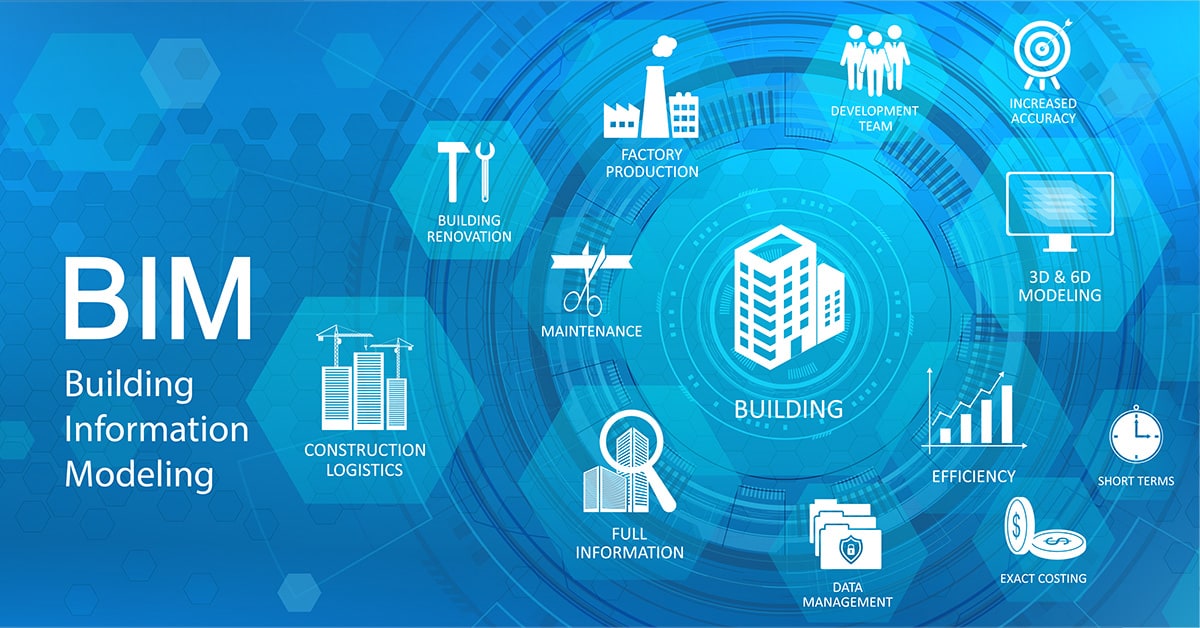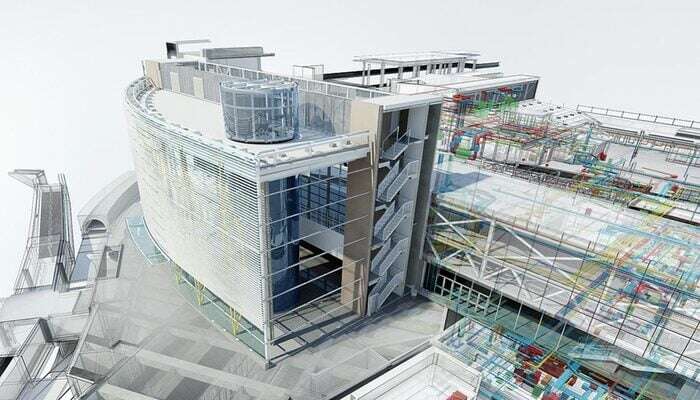Why BIM is a Must-Learn Skill: Importance, Benefits, & Real-World Examples

Table of Contents
Introduction To BIM
Importance Of BIM In The Industry
So, did you know that BIM (Building Information Modeling), is a super cool tool for the construction industry? It helps with precise data coordination, project feasibility, cost management, and scheduling. With AI integration, BIM has a lot of potential for the future! What's so great about BIM? Well, it aligns all stakeholders in a construction project and streamlines the schedule, which means fewer surprises during the work process. With BIM, architects can create templates and patterns that sync up with everyone on the team, eliminating repetitive tasks and allowing for seamless communication about the project. Plus, it provides a database that lets architects get creative and achieve unique results. You can change wall colours and textures, add interior decorations, set the lighting, and even simulate the sun at different times of the day!
But that's not all BIM can do. It's also a great tool to get everyone on the same page before the start of construction. Customers can align their ideas, architectural designs, and construction with the project team, ensuring that everything goes smoothly. Once construction is underway, BIM will help out with managing and maintaining the building. It's super helpful in identifying leaks, ensuring proper access, and tackling issues with water networks, electronic installation, cabling routes, and more. So if you're an architect or just interested in building design, you need to check about BIM!

Top 5 Reasons Why You Should Learn BIM Today
BIM (Building Information Modeling) is an essential tool for the architecture, engineering, and construction (AEC) industry, enhancing project efficiency, collaboration, and aligning with industry trends. BIM provides a digital representation of a building's physical and functional characteristics, offering numerous benefits. The top five reasons to learn BIM today include:

1. Teamwork Makes the Dream Work
Imagine diving into a digital wonderland where architects, engineers, and builders orchestrate a symphony of collaboration. BIM steps in as the superhero of teamwork, transforming construction into a high-tech playground. With BIM, it's like assembling your dream team on a shared digital canvas, fostering an environment where misunderstandings vanish, communication flows effortlessly, and the entire process becomes a collective adventure. It's not just teamwork; it's a collaborative masterpiece, akin to building a futuristic Lego masterpiece with your friends.
2. Money Talks, BIM Listens
BIM isn't just an acronym—it's your financial wizard in the construction toolbox. Think of it as your superhero sidekick to save serious cash. BIM's magic lies in foreseeing and nipping potential construction challenges in the bud, all within the virtual realm. It's like having a crystal ball that whispers money-saving insights into your ear, ensuring that your construction journey is a smooth sail without stormy surprises. Who wouldn't want a money-saving companion when navigating the intricate landscape of construction?
3. Seeing Is Believing (and Building)
Close your eyes and imagine a 3D model that allows you to stroll through your building before it stands tall. BIM opens a magic portal into the future of construction, offering you more than just a glimpse but an immersive experience. It's like having a backstage pass to your dream project, giving you the power to visualise, tweak, and perfect every detail before the construction crew swings into action. BIM doesn't just make buildings; it turns your visions into tangible, awe-inspiring realities.
4. From Cradle to Retirement Home
BIM isn't a passing trend; it's a steadfast companion for your building's entire journey. Visualise it as a trusted friend supporting your structure from its very conception to its golden years. BIM doesn't limit its enchantment to design and construction; it's the guiding hand through day-to-day operations, the troubleshooting guru during maintenance, and the rejuvenating force when it's time for a makeover. It's like an eternal youth serum, ensuring your building stays vibrant and relevant throughout its entire lifespan.
5. Career Booster
In the vibrant job market, BIM is the charismatic team player everyone desires. Learning BIM is akin to unlocking a golden ticket that propels your career into exciting dimensions. Companies in architecture, engineering, and construction are on the lookout for the BIM-savvy, and for good reason. It's not just a skill; it's a career passport, opening doors to thrilling opportunities and setting you on a path to career adventures. So, why not hop aboard the BIM bandwagon and let it steer you towards a future brimming with professional triumphs?
BIM Certification To Get Ahead Of The Competition
To advance your career in the AEC (Architecture, Engineering and Construction) industry, getting a BIM certification can be a game-changer. Having a BIM certification from a respected organisation or software provider can greatly enhance your skill set. This indicates a dedication to maintaining industry standards and staying current with the latest trends and technologies. A competitive edge in the job market can be gained by obtaining a BIM certification. Employers frequently look for candidates with specific skills and certifications, and having a BIM certification can enhance your profile. It's a great way to showcase your practical knowledge and skills in using BIM software tools for tasks such as design, modelling, and collaboration.
BIM certifications are recognized globally and are valuable in a construction industry that involves diverse teams. They guarantee transferable skills for various projects. Investing in your professional development will provide you with an advantage in promotions, so it's a wise decision. Employers have a preference for people who invest in their professional growth. The latest advancements in BIM technology and processes are covered in this book, which assists you in adapting to new methodologies. BIM Certification can increase your chances of being eligible for more opportunities and equip you to work in collaborative, project environments.
Novatr offers BIM Professional Course with a specific career-relevant curriculum designed and conducted by BIM specialists from top businesses. You will be taught by industry professionals from firms such as Cooper Carry, Arup, Schmidt Hammer Lassen, and even experts who have established their practices. The 6-month BIM course with placement consists of online part-time study that provides learners with a comprehensive understanding of BIM processes as well as software competence in modelling, clash detection, cloud collaboration, presentation, information management, and visual programming. The students will also have the opportunity to work on a live RIBA-structured capstone project to practise their BIM and design abilities, all while being led by industry experts.
Also Read: 8 BIM-related Technical and Soft Skills You Need for an Excellent BIM Career
Future Scope of BIM

I would like to share some thoughts on the potential of BIM to bring about better collaboration and value to the construction industry. BIM services in India are growing rapidly and are expected to replace Computer-Aided Design (CAD) soon. BIM involves planning, analysing, assessing, and programming operational activities, which have already been successful in developed countries.
BIM executives have a promising future, especially for experienced workers who can grow BIM competency based on their experience rather than ideas. They should broaden their knowledge to include all sectors where BIM is essential. BIM managers play an important role in AEC responsibilities, such as forecasting costs and timelines for BIM software adoption. It might help engineers find ways to reduce waste and improve sustainability throughout a building's lifecycle by providing accurate estimates of energy use, water consumption, and CO2 emissions.
Architects, engineers, and designers will be able to conduct digital walkthroughs of prospective structures in the future, allowing for more extensive visual and quantitative examination of individual parts inside the space. BIM's core components have not changed over the past 45 years, allowing architects and engineers to explore innovative ideas in a risk-free environment. Let's embrace BIM and work together to create a better future for the construction industry!
Real-World Examples: 3 Successful BIM Projects in the World
1. Shanghai Tower

The Shanghai Tower, a 600-metre-tall skyscraper, is a complex project that requires skilled and qualified project management to coordinate effectively between different teams. The tower is a multi-functional building with nine functional zones, seven structural systems, and over 30 electrical, mechanical, and intelligent subsystems. The project involved over 30 consulting companies in architectural structure, mechanical and electrical engineering, fire protection, and curtain wall design, as well as a dozen subcontractors in foundation, structure, and machinery.
To address the challenges of managing this large number of employees and specialists, the project managers sought an effective coordination system using Building Information Modeling (BIM) technology. BIM technology has proven to be valuable in systematising construction projects and facilitating collaboration, coordination, and data sharing. It unifies the platform for all disciplines to share their design files and creates a database for all design and construction phases, which can be referenced for future maintenance and development. Shanghai's Tower Construction & Development chose to use BIM technology in operating the design, structure, and construction processes of the tower. Autodesk applications were chosen for the system, including Revit Architecture, Structure, and MEP software for design and documentation processes, Autodesk Naviswork Manage software for employee coordination, and Ecotect Analysis for environmental analysis. Autodesk Consulting also implemented an on-site BIM environment for the local team and provided training and support services. By combining Autodesk's BIM technology with the deep expertise of Autodesk Consulting, the project successfully transitioned to BIM much faster, setting new standards for information management in construction projects in China.
2. The Len Lye Center, New Zealand

Len Lye, a celebrated New Zealand artist, was commissioned to create a museum commemorating his work. The project was built for a tight budget of over $8 million, limiting rework and redesign. The design focused on using stainless steel for the exterior façade, requiring precise onsite development. The building was designed to meet global building standards, ensuring temperature and accurate installation. The interior-external cohesion of the building was crucial, as the external material reflects natural light inside during the day and amplifies artificial light towards the outside. Any construction errors could disrupt this balanced relationship and the design itself. The project faced numerous challenges, including tight budget constraints, strict adherence to global building standards, and the need for accurate installation.
The project team implemented an all-accessible Building Information Modeling (BIM) system, ensuring accurate testing of the building's functionality before materials were sent to the construction site. This system allowed for collaboration among design, MEP, and construction teams, reducing errors during construction. The Common Data Environment served as a guideline module, ensuring the construction site was on schedule and in line with the plans, thereby reducing inefficiencies. This is a common benefit of using BIM for modern buildings.
3. Dongdaemun Design Park & Plaza, Seoul

The project, one of the largest in Asia, was designed by Zaha Hadid Architects and featured a museum, design lab, and plaza. The complex design was aesthetic and efficient, but the engineering and construction teams faced variability from the actual design. The project also involved the integration of 45,000 aluminium panels, each unique and scaled. Coordinating the various teams, including MEPs, sub-contracting, and labour management, was a major challenge. The communication and documentation styles of these teams had to be unified and readily available to stakeholders, making coordination a major challenge. The project faced challenges in sourcing and fabrication, sourcing and coordinating the various teams, and ensuring the project's success.
The Common Data Environment enables global teams to access all data in real time, facilitating communication and understanding of changes and RFIs. The visualisation of BIM made the impact on the process more tangible and also helped in the fabrication process by controlling panel cost, precision, and constructability using Multipoint Stretch Forming. Each cross-section of the model is detailed up to 30 centimetres, providing MEP and onsite teams with extensive and precise data. Overall, the BIM system has been a huge help in improving overall efficiency and effectiveness.
Conclusion
BIM is making waves in the AEC industry, completely transforming the way projects are approached and executed. BIM is incredible because it allows for seamless collaboration between professionals, helps to predict and avoid financial challenges, and so much more. It's truly an essential tool for anyone in the construction field. There are so many reasons to embrace BIM right now! It allows for a collaborative masterpiece, can save on costs, offers immersive visualisations, provides lifelong support to buildings, and can even boost your career. Plus, getting a BIM certification can open up even more opportunities for you in a competitive job market. Some real-world examples of BIM in action include the Shanghai Tower, Len Lye Center, and Dongdaemun Design Park & Plaza. These projects showcase just how successful BIM can be in tackling complex designs and ensuring precision from start to finish. While there are challenges to adopting BIM, the promise of a more efficient, collaborative, and sustainable future in construction is too good to pass up. I truly believe that embracing BIM is a strategic move that can empower professionals worldwide.
Interested in learning BIM today? Join the Novatr BIM Professional Course to learn technical skills with the appropriate tools while honing your soft skills. The course is taught by industry specialists and takes students through real-world RIBA-structured projects. For more industry and career information, see our Comprehensive BIM Guide and visit the Resources page.

 Thanks for connecting!
Thanks for connecting!
-1.png)


.png)


.jpg)


-1.png)


